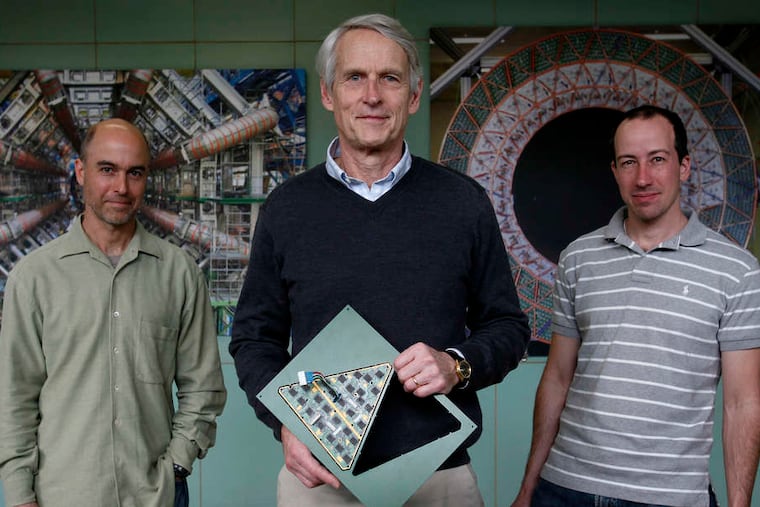Penn helps find hints of elusive Higgs particle
After days of rumor and anticipation, physicists Tuesday shared the first results from the biggest and most expensive scientific apparatus ever built - the 17-mile Large Hadron Collider on the French-Swiss border.

After days of rumor and anticipation, physicists Tuesday shared the first results from the biggest and most expensive scientific apparatus ever built - the 17-mile Large Hadron Collider on the French-Swiss border.
At Penn, physicist gathered at 8 a.m. to listen to a webcast from the European lab CERN, announcing hints of an invisible and short-lived particle called the Higgs, or Higgs Boson. That particle has been the last missing piece in the current theory of matter and the forces that govern it.
"The atmosphere at CERN was electric," said Penn physicist Brig Williams, who flew to Europe to hear the results first hand and represent his team.
Over the next year, Williams said, they expect to be able to find the Higgs definitively, if these hints are what they appear and not a statistical fluke. But today may be the day they remember.
"If this is the Higgs, we will probably look back at this as when we saw the first honest hint," said Penn physicists Mark Trodden.
The 27 Penn scientists involved with the project already knew half the story because they had been looking through one of two windows into the world exposed by the collider. That window, named Atlas, is a doughnut-shaped detector, 80 feet in diameter, designed to detect exotic particles like the Higgs. Another team is using a similarly large and elaborate detector called CMS. Neither team had been privy to the results of the other, but that changed Tuesday.
The Penn team were relieved to learn that the other team, operating the CMS detector, didn't present stronger, more statistically significant evidence for a Higgs particle. This represents the first particle to be found in over 16 years, and no one wants to be on the second team to find it.
The collider works by accelerating beams of protons, which are components of the atomic nucleus, to near the speed of light and steering them into head-on collisions.
Those collisions, which happen by the millions per second, produce concentrations of energy unlike anything that has existed since the origin of the universe.
The energy can spontaneously condense into exotic bits of matter through the relationship defined by the famous Einstein equation E=mc2. Since no one has ever concentrated this much energy before, the physicists hoped not only to see the Higgs particle but some surprises too.
The Higgs is named after the English physicist Peter Higgs, who proposed a theory in 1964 to explain a mystery: why the constituents of matter have mass but the light particle, or photon, is massless. Scientists had gotten used to the idea that electric and magnetic fields could pervade space, and Higgs proposed another field, bearing his name, through which particles could acquire mass.
Rutgers physicist Matt Strassler explained that Higgs particles can be thought of as waves or ripples in the Higgs field. The particle is the manifestation of the Higgs theory that's potentially testable.
Several other physicists devised nearly identical theories independently, but Higgs was the name that best stuck to the theory, the field and the particle.
In the 1970s, the Higgs field was incorporated into a Nobel-winning theory that united electromagnetism with one of the forces involved in nuclear reactions. Now the Higgs idea is woven into the so-called Standard Model, which describes the constituents of matter and the forces that act on them.
For years, the Higgs particle has remained the only missing piece in the Standard Model. In the late 1980s, physicists planned on finding it with a 50-mile-long, mega-accelerator called the Superconducting Supercollider. Tunnels were begun near Waxahachie, Texas, before it was killed by Congress in 1993.
At the same time, CERN was building a rival machine. Many U.S. scientists joined what became an international collaboration on the collider, which cost about $8 billion to build and $1 billion a year to run.
Each of the two detectors required several thousand people to build and operate. Penn scientists built a piece of the Atlas detector's heart. Called the transition radiation tracker, it uses 300,000 gas-filled tubes the size of drinking straws. As particles move through the straws, their paths are photographed.
Neither detector actually sees the Higgs. That's because it lasts less than a billionth of a second before exploding into a shower of other particles that fly out in different directions. It's from pictures of the debris that the scientists try to assess whether a Higgs was there, but even then, there are always mundane events that can produce the same exact spray of subatomic debris.
So proof must be statistical, and to claim discovery, either team would have to leave less than a one in a million chance of statistical error. One in a thousand or even ten thousand isn't good enough.
But they are expecting the Higgs, since previous experiments have narrowed down the energy that should be required to produce it.
Both teams were converging on the same range for the Higgs mass, which is measured in units called gigaelectron volts or GEV. CMA announced a range of 115-127 Gev, and Atlas, 116-130. A CERN press release referred to the findings as "tantalizing hints." The Penn physicists expect a more definitive announcement in 2012.
The collider will run for years ahead, as scientists search for new particles and unexpected phenomena. Strassler, of Rutgers, said the point isn't just to find the Higgs but to reach out across a new frontier and look for things that can't be explained with current theory.
Historically, physics relies on discrepancies and misfit phenomena in order to move forward. "We hope we'll find answers to questions we didn't even know were questions."